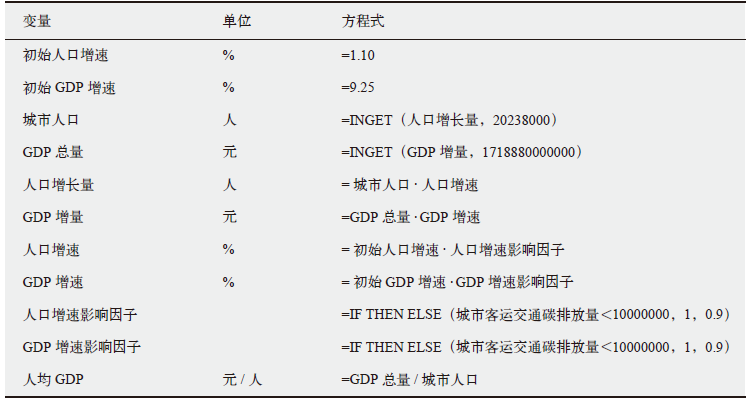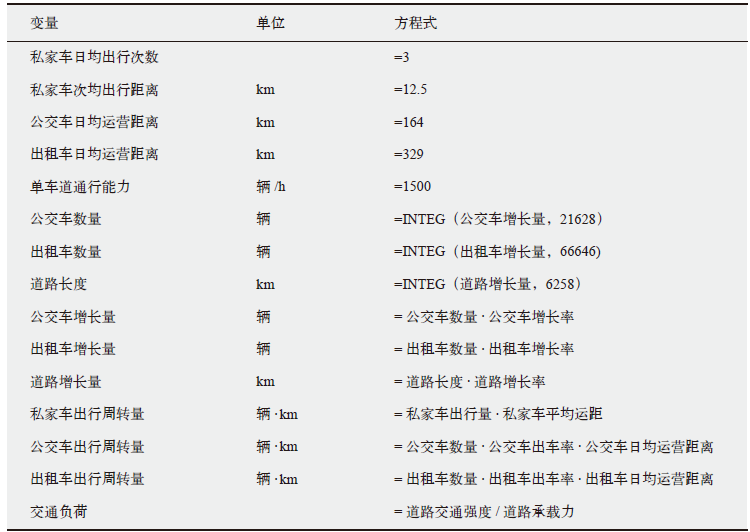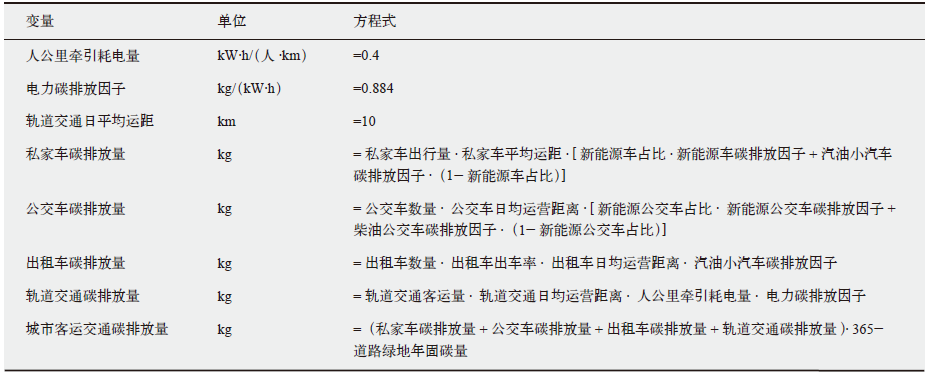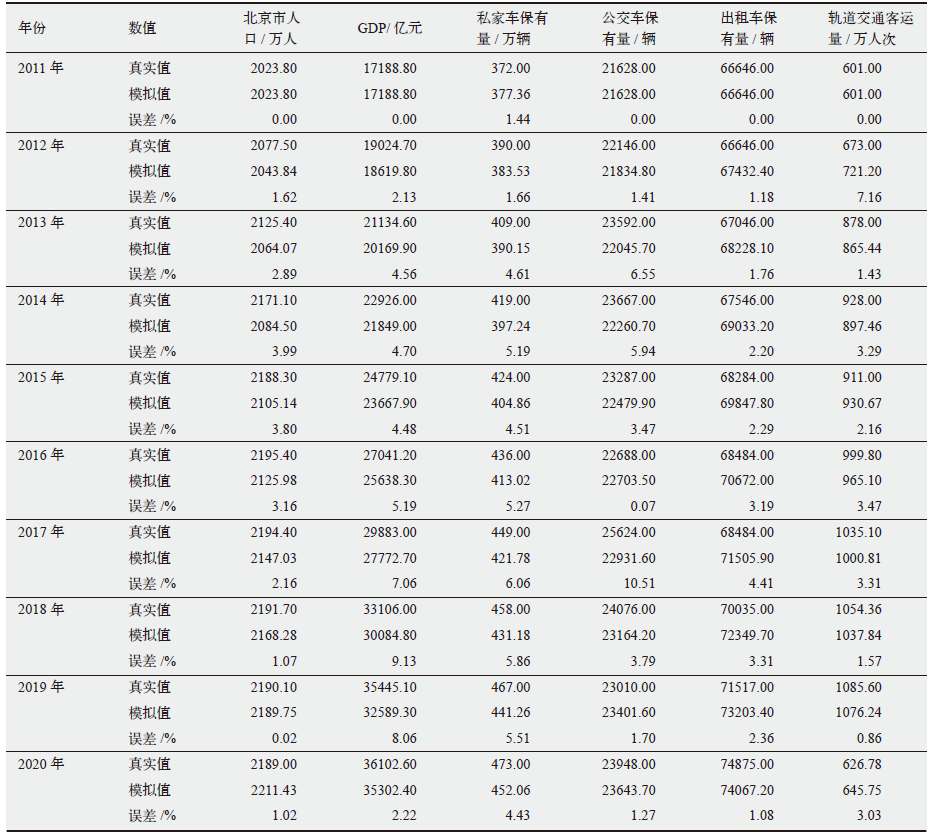气候变化研究进展 ›› 2023, Vol. 19 ›› Issue (3): 357-370.doi: 10.12006/j.issn.1673-1719.2022.138
基于系统动力学的城市客运交通减碳情景模拟研究
戈秋虞, 徐艺诺, 邱荣祖, 胡喜生, 张园园, 刘娜翠, 张兰怡( )
)
- 福建农林大学交通与土木工程学院,福州 350108
-
收稿日期:2022-05-31修回日期:2022-07-12出版日期:2023-05-30发布日期:2022-12-09 -
通讯作者:张兰怡,女,副教授,lyzhang@fafu.edu.cn -
作者简介:戈秋虞,男,硕士研究生 -
基金资助:福建省社科基金项目(FJ2022B065);福建农林大学“杰出青年科研人才”计划项目(社会科学类)(xjq2020S4);福建省中青年教师教育科研项目(JAS21057);福建农林大学科技创新专项基金项目(KFb22101XA);福建农林大学校级大学生创新创业训练计划项目(202210389344);福建省科技创新战略研究联合项目(2022R0137)
Scenario simulation of urban passenger transportation carbon reduction based on system dynamics
GE Qiu-Yu, XU Yi-Nuo, QIU Rong-Zu, HU Xi-Sheng, ZHANG Yuan-Yuan, LIU Na-Cui, ZHANG Lan-Yi( )
)
- College of Transportation and Civil Engineering, Fujian Agriculture and Forestry University, Fuzhou 350108, China
-
Received:2022-05-31Revised:2022-07-12Online:2023-05-30Published:2022-12-09
摘要:
随着我国城市化和机动化的快速发展,城市客运交通已成为城市二氧化碳排放的重要来源。在“双碳”目标的大背景下,如何实现城市客运交通的减排成为人们关注的重点问题。利用北京市数据,综合考虑道路绿地和新能源汽车占比对城市客运交通碳排放的影响,建立了北京市客运交通碳排放的系统动力学模型,测算出北京市2011—2020年城市客运交通碳排放总量;根据碳达峰愿景设定了5种减排情景,并评估了不同情景在2021—2025年的减排效果。结果表明:私家车是城市客运交通碳排放的最主要贡献者;2019年城市道路绿地的年固碳量为同一时期公交车年碳排放量的28%;单情景下,北京市客运交通碳排放未能在2021—2025年间达到峰值,减排效果最佳的情景为“控制私人交通出行需求”;而北京市客运交通至少需要在两种减排情景的作用下才能在2030年前实现碳达峰。
引用本文
戈秋虞, 徐艺诺, 邱荣祖, 胡喜生, 张园园, 刘娜翠, 张兰怡. 基于系统动力学的城市客运交通减碳情景模拟研究[J]. 气候变化研究进展, 2023, 19(3): 357-370.
GE Qiu-Yu, XU Yi-Nuo, QIU Rong-Zu, HU Xi-Sheng, ZHANG Yuan-Yuan, LIU Na-Cui, ZHANG Lan-Yi. Scenario simulation of urban passenger transportation carbon reduction based on system dynamics[J]. Climate Change Research, 2023, 19(3): 357-370.

图9 单一情景下北京市客运交通碳排放量 注:CPD,控制私人交通出行需求;PVE,发展新能源汽车;IEE,提高能源效率;IRC,提高道路承载能力;IRG,提高道路绿化水平;BS,基准情景。
Fig. 9 Urban passenger transportation carbon emissions under single strategy scenario in Beijing

图12 四情景及综合情景下北京市客运交通碳排放量
Fig. 12 Urban passenger transportation carbon emissions under quadruple strategy scenario and comprehensive scenario in Beijing
| [1] | 胡晓伟, 包家烁, 安实, 等. 碳达峰下城市交通运输减排治理策略研究[J]. 交通运输系统工程与信息, 2021, 21 (6): 244-256. |
| Hu X W, Bao J S, An S, et al. Urban transportation emission reduction governance strategies under peak carbon dioxide emissions[J]. Journal of Transportation Systems Engineering, 2021, 21 (6): 244-256 (in Chinese) | |
| [2] |
Zhang L L, Long R Y, Li W B, et al. Potential for reducing carbon emissions from urban traffic based on the carbon emission satisfaction: case study in Shanghai[J]. Journal of Transport Geography, 2020, 85: 102733
doi: 10.1016/j.jtrangeo.2020.102733 URL |
| [3] | 林丹婷, 张兰怡, 陈诚, 等. 城市核心区域乘用车碳排放的时空分布特征[J]. 福建农林大学学报: 自然科学版, 2019, 48 (5): 664-672. |
| Lin D T, Zhang L Y, Chen C, et al. Spatiotemporal distribution characteristics of the carbon emission from passenger cars in urban core region[J]. Journal of Fujian Agriculture and Forestry University: Natural Science Edition, 2019, 48 (5): 664-672 (in Chinese) | |
| [4] |
Lin D T, Zhang L Y, Chen C, et al. Understanding driving patterns of carbon emissions from the transport sector in China: evidence from an analysis of panel models[J]. Clean Technologies and Environmental Policy, 2019, 21 (6): 1307-1322
doi: 10.1007/s10098-019-01707-y URL |
| [5] | 黄莹, 郭洪旭, 廖翠萍, 等. 基于LEAP模型的城市交通低碳发展路径研究: 以广州市为例[J]. 气候变化研究进展, 2019, 15 (6): 670-683. |
| Huang Y, Guo H X, Liao C P, et al. Study on low-carbon development path of urban transportation sector based on LEAP model: take Guangzhou as an example[J]. Climate Change Research, 2019, 15 (6): 670-683 (in Chinese) | |
| [6] | 张兰怡, 卢秋萍, 张园园, 等. 福建省交通碳排放影响因素与减碳趋势研究[J]. 哈尔滨商业大学学报:自然科学版, 2022, 38 (3): 360-375. |
| Zhang L Y, Lu Q P, Zhang Y Y, et al. Research on influencing factors and carbon reduction trend of transportation carbon emissions in Fujian Province[J]. Journal of Harbin University of Commerce: Natural Sciences Edition, 2022, 38 (3): 360-375 (in Chinese) | |
| [7] | 戈秋虞, 张兰怡, 邱荣祖, 等. 基于GDIM法的福建省交通碳排放驱动因素分析[J]. 福建农林大学学报: 自然科学版, 2022, 51 (1): 131-136. |
| Ge Q Y, Zhang L Y, Qiu R Z, et al. Analysis on driving factors of transportation carbon emissions in Fujian Province based on GDIM[J]. Journal of Fujian Agriculture and Forestry University: Natural Science Edition, 2022, 51 (1): 131-136 (in Chinese) | |
| [8] | Wei L, Bai L. System dynamics modeling and policy simulation for urban traffic: a case study in Beijing[J]. Environmental Modeling & Assessment, 2017, 22 (4): 363-378 |
| [9] |
Liu X, Ma S F, Tian J F, et al. A system dynamics approach to scenario analysis for urban passenger transport energy consumption and CO2emissions: a case study of Beijing[J]. Energy Policy, 2015, 85: 253-270
doi: 10.1016/j.enpol.2015.06.007 URL |
| [10] | 王继峰, 陆化普, 彭唬. 城市交通系统的SD模型及其应用[J]. 交通运输系统工程与信息, 2008, 8 (3): 83-89. |
| Wang J F, Lu H P, Peng H. System dynamics model of urban transportation system and its application[J]. Journal of Transportation Systems Engineering, 2008, 8 (3): 83-89 (in Chinese) | |
| [11] | 麦文隽, 邹乐乐, 王毅, 等. 城市客运交通节能减排潜力分析: 以镇江市为例[J]. 城市问题, 2017 (8): 31-41. |
| Mai W J, Zou L L, Wang Y, et al. Analysis to the potential of energy-saving and emission-reduction of urban passenger transport: a case study of Zhenjiang city[J]. Urban Problems, 2017 (8): 31-41 (in Chinese) | |
| [12] | 魏贤鹏, 朝鲁, 战秋艳, 等. 基于系统动力学的城市道路交通污染控制问题研究[J]. 数学的实践与认识, 2017, 47 (23): 117-126. |
| Wei X P, Zhao L, Zhan Q Y, et al. Research on urban road traffic pollution control based on system dynamics[J]. Mathematics in Practice and Theory, 2017, 47 (23): 117-126 (in Chinese) | |
| [13] |
Nima S, Hajinezhad A, Noorollahi Y. Developing a system dynamics approach for CNG vehicles for low-carbon urban transport: a case study[J]. International Journal of Low-Carbon Technologies, 2021, 16 (2): 577-591
doi: 10.1093/ijlct/ctaa085 URL |
| [14] |
İrfan B, Bayram I, Koc M. Impact assessment of supply-side and demand-side policies on energy consumption and CO2 emissions from urban passenger transportation: the case of Istanbul[J]. Journal of Cleaner Production, 2019, 219: 391-410
doi: 10.1016/j.jclepro.2019.02.064 URL |
| [15] | 邵艳, 张弢, 牟星宇. 高速公路路域范围内绿地的碳清除作用[J]. 公路交通科技: 应用技术版, 2018, 14 (9): 322-324. |
| Shao Y, Zhang T, Mou X Y. Carbon removal effect of green space in highway area[J]. Journal of Highway and Transportation Research and Development, 2018, 14 (9): 322-324 (in Chinese) | |
| [16] | 邓旭东, 刘春玲, 赵利利, 等. 考虑双积分和碳交易背景下基于最优控制的新能源汽车生产决策分析[J/OL]. 计算机集成制造系统, 2022 [2022-05-20]. http://kns.cnki.net/kcms/detail/11.5946.TP.20220317.2003.005.html. |
| Deng X D, Liu C L, Zhao L L, et al. Production decision analysis of new energy vehicles based on optimal control considering dual credit and carbon trade policy[J/OL]. Computer Integrated Manufacturing Systems, 2022 [2022-05-20]. http://kns.cnki.net/kcms/detail/11.5946.TP.20220317.2003.005.html (in Chinese) | |
| [17] | 李茜. 城市客运交通能源需求与碳排放预测方法及其应用研究[D]. 北京: 北京理工大学, 2018. |
| Li Q. Study on the energy demand and carbon emissions prediction method and its application in urban passenger transport sector[D]. Beijing: Beijing Institute of Technology, 2018 (in Chinese) | |
| [18] | 李沛妍. 基于系统动力学的城市低碳交通发展模式与结构优化[D]. 西安: 西安建筑科技大学, 2018. |
| Li P Y. Urban low carbon transportation development model and structure optimization based on system dynamics[D]. Xi’an: Xi’an University of Architecture and Technology, 2018 (in Chinese) | |
| [19] | 刘爽. 基于系统动力学的大城市交通结构演变机理及实证研究[D]. 北京: 北京交通大学, 2010. |
| Liu S. Mechanism and empirical analysis on the evolution of urban traffic structure based on system dynamics[D]. Beijing: Beijing Jiaotong University, 2010 (in Chinese) | |
| [20] | 张青云, 吕伟娅, 徐炳乾. 华北地区城市绿地固碳能力测算研究[J]. 环境保护科学, 2021, 1 (47): 41-48. |
| Zhang Q Y, Lv W Y, Xu B Q. Study on the calculation of carbon sequestration capacity of urban green space in North China[J]. Environmental Protection Science, 2021, 1 (47): 41-48 (in Chinese) | |
| [21] | 邓吴婕, 李楠, 陈智, 等. 深圳特区城市植被的固碳释氧效应[J]. 中山大学学报: 自然科学版, 2010, 4 (49): 86-92. |
| Deng W J, Li N, Chen Z, et al. The effect of CO2 sequestration and O2 release of urban vegetation in Shenzhen special zone[J]. Acta Scientiarum Naturalimu Universitatis Sunyatseni, 2010, 4 (49): 86-92 (in Chinese) | |
| [22] | 赵艳玲. 上海社区绿地植物群落固碳效益分析及高固碳植物群落优化[D]. 上海: 上海交通大学, 2014. |
| Zhao Y L. Analysis on carbon fixation effection and optimizational disposition about plant communities of community greenspace in Shanghai[D]. Shanghai: Shanghai Jiao Tong University, 2014 (in Chinese) | |
| [23] | 金力豪. 园林植物碳储存及碳汇效益研究: 以杭州云制造小镇为例[D]. 杭州: 浙江农林大学, 2019. |
| Jin L H. Carbon storage and carbon sink benefits of garden plants: taking cloud manufacturing town as an example[D]. Hangzhou: Zhejiang A&F University, 2019 (in Chinese) | |
| [24] | 吕晨, 张哲, 陈徐梅, 等. 中国分省道路交通二氧化碳排放因子研究[J]. 中国环境科学, 2021, 41 (7): 3122-3130. |
| Lv C, Zhang Z, Chen X M, et al. Study on CO2 emission factors of road transport in Chinese provinces[J]. China Environmental Science, 2021, 41 (7): 3122-3130 (in Chinese) | |
| [25] | 北京市统计局. 北京统计年鉴[R]. 北京: 中国统计出版社, 2020. |
| Bureau of Statistics of Beijing. Beijing statistical yearbook[R]. Beijing: China Statistics Press, 2020 (in Chinese) | |
| [26] | 北京交通发展研究院. 2020年北京交通发展年报 [EB/OL]. 2020 [2022-05-27]. https://www.bjtrc.org.cn/List/index/cid/7.html. |
| Beijing Transport Institute. 2020 Beijing transport development annual report [EB/OL]. 2020 [2022-05-27]. https://www.bjtrc.org.cn/List/index/cid/7.html (in Chinese) | |
| [27] | 中华人民共和国环境保护部. 道路机动车大气污染物排放清单编制技术指南 (试行)[R]. 北京: 中华人民共和国环境保护部门科技标准司, 2014. |
| Ministry of Environment Protection of The People’s Republic of China. Technical guide for preparation of air pollutant emission list of road motor vehicles (Trial)[R]. Beijing: Department of Technology Standards of Ministry of Environment Protection of The People’s Republic of China, 2014 (in Chinese) | |
| [28] |
贾书伟, 严广乐. 基于SD-GM循环预测理论的机动车污染物收费政策效应分析[J]. 系统工程理论与实践, 2019, 39 (9): 2436-2450.
doi: 10.12011/1000-6788-2018-1593-15 URL |
| Jia S W, Yan G L. Effects of the policy of air pollution charging fee based on system dynamics and grey model approach[J]. System Engineering-Theory &Practice, 2019, 39 (9): 2436-2450 (in Chinese) | |
| [29] | 盛强. 交通领域碳减排的影响机制及情景分析: 以北京市为例[D]. 北京: 北京化工大学, 2018. |
| Sheng Q. The impact mechanism and scenario analysis of carbon emission reduction in transportation sector: a case study of Beijing[D]. Beijing: Beijing University of Chemical Technology, 2018 (in Chinese) | |
| [30] |
庞可, 张芊, 马彩云, 等. 基于LEAP模型的兰州市道路交通温室气体与污染物协同减排情景模拟[J]. 环境科学, 2022, 43 (7): 3386-3395. DOI: 10.13227/j.hjkx.202109119.
doi: 10.13227/j.hjkx.202109119 URL |
|
Pang K, Zhang Q, Ma C Y, et al. Forecasting of emission co-reduction of greenhouse gases and pollutants for the road transport sector in Lanzhou based on the LEAP model[J]. Environmental Science, 2022, 43 (7): 3386-3395. DOI: 10.13227/j.hjkx.202109119 (in Chinese)
doi: 10.13227/j.hjkx.202109119 URL |
|
| [31] | 陈振, 昝哲. 郑州市交通政策影响的系统动力学模型与仿真[J]. 河南农业大学学报, 2021, 55 (5): 917-927. |
| Chen Z, Zan Z. Modeling and simulation of urban traffic policy impact based on system dynamics of Zhengzhou city[J]. Journal of Henna Agricultural University, 2021, 55 (5): 917-927 (in Chinese) |
| [1] | 田佩宁, 毛保华, 童瑞咏, 张皓翔, 周琪. 我国交通运输行业及不同运输方式的碳排放水平和强度分析[J]. 气候变化研究进展, 2023, 19(3): 347-356. |
| [2] | 田利军, 秦文, 黎杰. “双碳”目标下ETS与航空公司绿色全要素生产率[J]. 气候变化研究进展, 2023, 19(3): 320-333. |
| [3] | 杨姗姗, 郭豪, 杨秀, 李政. 双碳目标下建立碳排放总量控制制度的思考与展望[J]. 气候变化研究进展, 2023, 19(2): 191-202. |
| [4] | 谭显春, 高瑾昕, 曾桉, 幸绣程. 绿色金融改革创新试验区政策对碳排放的影响评估[J]. 气候变化研究进展, 2023, 19(2): 213-226. |
| [5] | 李晓易, 吴睿. 交通运输温室气体核算边界和测算方法研究[J]. 气候变化研究进展, 2023, 19(1): 84-90. |
| [6] | 陶学宗, 王谦益, 李汉卿. 船舶使用岸电的经济性分析[J]. 气候变化研究进展, 2022, 18(4): 492-502. |
| [7] | 宝哲, 周小亮. 数字赋能与城市碳排放——基于下一代互联网示范城市的准自然试验[J]. 气候变化研究进展, 2022, 18(4): 503-508. |
| [8] | 徐一剑, 李潭峰, 徐丽丽. 国土空间总体规划温室气体核算模型[J]. 气候变化研究进展, 2022, 18(3): 355-365. |
| [9] | 冯国会, 崔航, 常莎莎, 黄凯良, 王茜如. 近零能耗建筑碳排放及影响因素分析[J]. 气候变化研究进展, 2022, 18(2): 205-214. |
| [10] | 张海军, 段茂盛. 中国试点ETS的碳减排效果评估——基于分省高耗能工业子行业数据的分析[J]. 气候变化研究进展, 2021, 17(5): 579-589. |
| [11] | 王敏, 冯相昭, 安祺, 卓岳, 赵梦雪, 杜晓林, 王鹏. 基于脱钩指数和LMDI的青海省绿色低碳发展策略研究[J]. 气候变化研究进展, 2021, 17(5): 598-607. |
| [12] | 王利宁, 陈文颖, 戴家权, 向征艰, 龚金双. 智能互联重塑中国能源体系[J]. 气候变化研究进展, 2021, 17(2): 204-211. |
| [13] | 原嫄, 孙欣彤. 城市化、产业结构、能源消费、经济增长与碳排放的关联性分析——基于中国省际收入水平异质性的实证研究[J]. 气候变化研究进展, 2020, 16(6): 738-747. |
| [14] | 陈怡, 田川, 曹颖, 刘强, 郑晓奇. 中国电力行业碳排放达峰及减排潜力分析[J]. 气候变化研究进展, 2020, 16(5): 632-640. |
| [15] | 魏琦,周红伟,李林静. 不同监管强度下碳排放权交易违约行为的实验研究[J]. 气候变化研究进展, 2020, 16(3): 345-354. |
| 阅读次数 | ||||||
|
全文 |
|
|||||
|
摘要 |
|
|||||
















